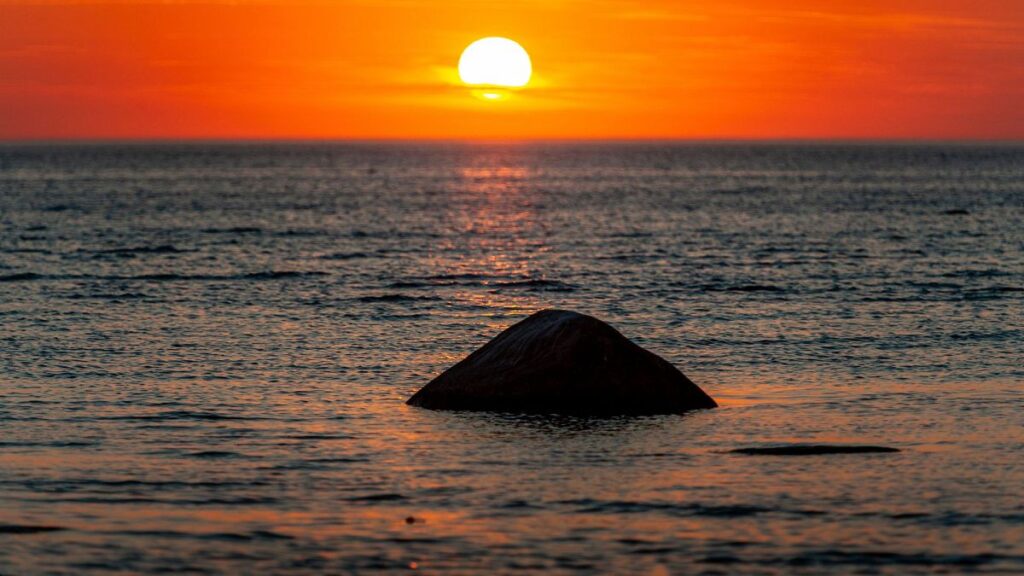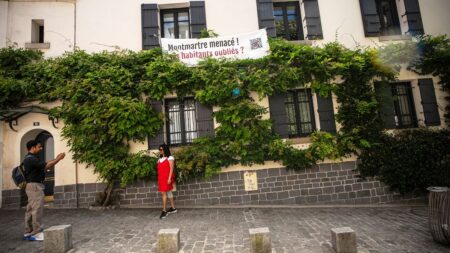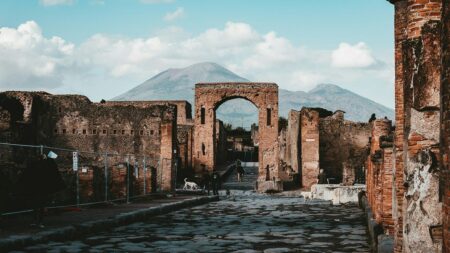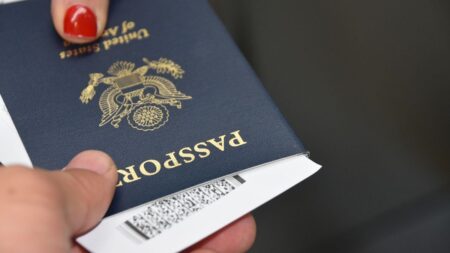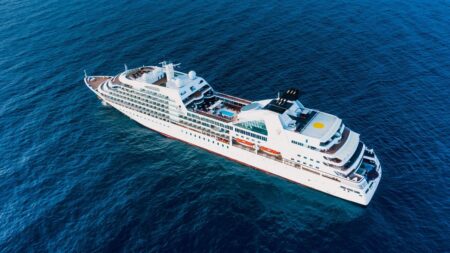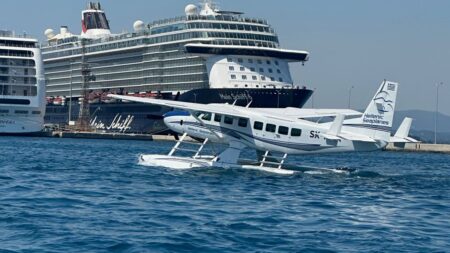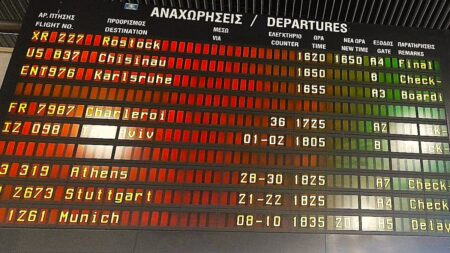On a crisp morning in late June 2021, Meelis Kitsing, and her then eight-year-old daughter cycled along a sandy path on Ruhnu, one of Estonia’s most remote islands. As they reach the shore, with the sea a sheet of shimmering silver, her daughter looks around, puzzled.
“Why did we come here?” she asks.
“To go to the beach,” replies Kitsing.
Her daughter pauses, scanning the horizon, kilometres of untouched sand stretching into the distance in every direction, with not a soul in sight.
“But…there are no people.”
Kitsing, rector of Estonian Business School, tells Euronews Travel that for her daughter, beaches in mainland Estonia or on larger islands such as Hiiumaa usually mean at least a handful of other people.
“On our trips to South Asia or Greece, finding a patch of sand without a neighbouring sun lounger is nearly impossible. That day, with the air in the mid-twenties, the water over 20 degrees Celsius, and the sun warm on our faces, it felt like the Mediterranean in early October but without the crowds,” she says.
With many of Europe’s most popular holiday destinations threatened by overtourism, travellers are increasingly looking for pristine spots where they can enjoy some solitude and rejuvenate away from bustling cities.
Increasingly common extreme weather events such as heatwaves, droughts and wildfires in traditional beach destinations in Greece, Cyprus and Spain have also led to travellers choosing relatively cooler beaches in the Baltics.
The rise of digital nomadism has also led to remote workers looking for more peaceful places with good internet connectivity, where they can immerse in local culture, but still work without too many issues.
“The opportunity to be a digital nomad means tourists can spend longer in a place and get to know it better. Also, lesser-known places are likely to be cheaper to stay for longer periods of time than tourist hot-spots like Barcelona or Lisbon,” says Professor Graham Miller, academic director of the Westmont Institute of Tourism and Hospitality at Nova School of Business and Economics.
Singing sands and ancient churches
Part of a larger archipelago with other islands such as Muhu, Saaremaa, Kihnu, Vormsi and Hiiumaa, Ruhnu is one of the least visited islands in Europe. Located about 70 kilometres off the Estonian coastline, it has a population of only 150 official residents.
The island is part of the UNESCO “Man and Biosphere” programme, which finds ways to encourage sustainable development, while protecting ecosystems and improving human livelihoods.
One of Ruhnu’s highlights is the singing sands on Limo beach, which produce a high-pitched squeaking sound when walked upon.
The island’s lighthouse is a testament to French engineering, with a unique metal structure. Designed by engineer Louis Édouard Lecointre, its assembly parts were produced in France at the Forges et Chantiers de la Méditerranée shipyard in Le Havre. The lighthouse is the only preserved one of its kind in the Baltic Sea region, having been operational for more than 100 years.
Ruhnu also has the oldest wooden church in Estonia still in use, the Ruhnu wooden church, built in 1644. Side by side stands a newer stone church, built in 1912. For more local history, visit the Korsi Farm, a well-preserved example of a traditional Swedish farmhouse from the island’s Swedish settlement period and the Ruhnu Museum for historical documents and ancient artefacts.
Ruhnu is also renowned for rare wildlife such as its native sheep breed, the Estonian Ruhnu sheep, as well as red foxes, roe deer and seals, among others. Bird species such as the long-tailed duck and the velvet scoter can also be seen.
“You should definitely experience forest bathing – lying on moss under pine trees, walking on kilometres-long empty picturesque beaches with singing sands, and having a picnic in coastal pastures with diverse nature brings you into contact with the natural world,” Mihkel Urmet, co-founder of sustainable seaweed cultivation company Planet Ruhnu, says.
“There are secret beaches that no one else will visit, mystical trees and visible ruins from ancient eras, opportunities for spotting rare birds and viewing seals sitting on stones.”
For an authentic taste of Ruhnu, tuck into local delicacies such as Baltic herring and smoked flounder. Visitors can also forage for wild blueberries and mushrooms in the forests.
“Have a beer with locals and ask about stories of the bear who visited the island, or inquire where one can taste seal meat or try a gin and tonic made with local seaweed gin. Participate in workshops about bobbin lace or register for the super fun violin camp, try to buy tickets to Estonia’s smallest festival RuhnuRahu, see the sunset from the top of the lighthouse, or ask local fishermen to take you fishing,” Urmet says.
You can stay in a range of accommodations, from modern holiday houses to traditional farm stays and glamping, such as Antsu Ait, Liise Farm and Ruhnu Beach Glamping.
Visitors can travel to the island by a small eight-seater plane in winter or by ships which can accommodate around 50 people in summer. Travellers can also take a ship from Latvia to Ruhnu in summer.
Swedish heritage and peaceful meadows
Another remote island, Vormsi, is also relatively overlooked by visitors and features rich Swedish culture and heritage, influenced by the island’s history as a Swedish-speaking settlement.
Visit the distinctive Vormsi Cemetery, with centuries-old wheel crosses made from sandstone and limestone. These are usually found only in areas settled by coastal Swedes. Traditional wooden houses dot villages like Sviby and Hullo, whose linear layout and architecture also showcase Swedish influence.
Explore the Vormsi Farm Museum for a glimpse into traditional island life in the early 20th century, or head to St.Olav’s Church, a 14th-century church in Hullo. Visitors can learn about the island’s maritime history and culture as well at Sviby Port.
Outdoor lovers can find many activities, like birdwatching for rare species like corn crakes and cycling. Hike along the Rumpo Hiking trail, with beautiful views of the Rumpo peninsula, renowned for its diverse landscapes and juniper trees.
Catch a glimpse of protected species such as the long-eared bat and natterjack toad, if you’re lucky. You can also see wild boar, lynx and the occasional bear.
With peaceful meadows, forests and coastal landscapes, Vormsi offers visitors a true chance to slow down and recharge.
Here you can choose from homestays like Ada Homestay, camping options like Diby Camping and guesthouses like Elle-Malle’s Guesthouse.
Matriarchal culture and handicrafts
Kihnu Island, another less-visited island, has been recognised by UNESCO for its unique cultural space, which features a prominent matriarchal society.
Women usually manage daily life, as well as activities such as dances, music and handicrafts, whereas men take care of fishing and seafaring activities. The island also has its own dialect, which is taught in schools and is different from standard Estonian.
Wear a kort, a traditional bright red wool skirt, while you try your hand at a knitting or weaving class, or participate in local folk singing and dance masterclasses.
Visit the Kihnu Museum to learn more about island heritage and history, or explore the Kihnu Cemetery, which is sacred to islanders. Follow up with a trip to the Kihnu Lighthouse, which was originally brought from England in pieces.
You can rent a bicycle and explore the island, go fishing or take a yacht trip to Pärnu.
The island hosts a number of festivals too, such as the Kihnu Sea Festival, the Baltic Herring Festival, the knitting festival, the sauna festival, the midsummer festival and the violin festival.
Like Ruhnu, Kihnu also offers a variety of guesthouses, farms and glamping options like Kastani Guesthouse, Risti Farm and Glamping & Homestay in Kihnu.
Stay in a nature reserve on Abruka Island
Abruka Island gives visitors the chance to visit and stay on a nature reserve, containing Europe’s northernmost protected broadleaf forest. Keep an eye out for white-backed woodpeckers, black grouse, pygmy owls and white-tailed eagles, among others, from the island’s bird observation tower.
Go to the Abruka Museum for insights into island history and culture, as well as a disc golf course and an ice-cream shop.
Explore the broadleaf forest and visit the Lippmaa linden tree, a uniquely shaped linden tree named after the botanist Teodor Lippmaa, or wade through the water to Vahase Island, to see the giant boulders.
Hunt for the mysterious chiming rock on the northern end of Abruka, which is believed to grant wishes to the one who finds it and knocks on it, or head to the Abruka chapel for a quiet moment.
Choose between guesthouses, hotels and vacation rentals such as Ekesparre Boutique Hotel, Merily Guest Accommodation and Vahtra Talu, which offers a hot tub, sauna and BBQ facilities.
The island is reachable by boat from Roomassaare on Saaremaa island; however, travellers need to check schedules in advance due to potential weather issues.
Read the full article here







